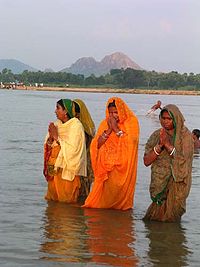- Falgu River
-
Falgu River River Country India State Bihar City Gaya Source Junction of Lilajan and Mohana - location near Gaya - coordinates 24°43′41″N 85°00′47″E / 24.72806°N 85.01306°E Mouth A branch of the Punpun The Falgu River (also spelt Phalgu River) (Hindi: फल्गु नदी) which flows past Gaya, India in the Indian state of Bihar, is a sacred river for Hindus.
Contents
Course
The Falgu is formed by the junction, some two miles below Bodh Gaya, of the Lilajan (also called Niranjana or Nilanjan) and the Mohana, two large hill streams each of which is over 300 yards wide.[1] The Falgu is also mentioned as Niranjana.[2] The united stream flows on to the north past the town of Gaya, where it attains a breadth of over 900 yards. The Falgu here impinges on a high rocky bank, on the steep sides of which are many paved stairs leading down to the river bed, while high above are the Vishnupad Mandir, with many minor shrines around it. It then runs in a north-easterly direction for about 17 miles (27 km), and opposite the Barabar hills it again takes the name of Mohana, and divides into two branches which eventually flow into a branch of the Punpun.[1]
The Falgu like the confluent streams, Lilajan and Mohana, is subject to high floods during the monsoons but in other seasons of the year it dwindles to an insignificant stream wandering through a wide expanse of sand.[1]
Religious significance
 Women performing Chhath Puja in the Falgu River in Gaya.
Women performing Chhath Puja in the Falgu River in Gaya.
The portion of the course of the Falgu flowing by Gaya is sacred to the Hindus. It is the first holy site visited by the pilgrim and here his first offering must be made for the souls of his ancestors. According to the Gaya Mahatmya, which forms part of the Vayu Purana, the Falgu is the embodiment of Vishnu himself. One tradition states that it formerly flowed with milk.[1]
According to Hindu belief, the soul wanders after death until pindadan, or religious service seeking salvation for the dead from the cycle of rebirth, is performed. The fortnight-long pitrapaksh period is considered auspicious to offer pindadan. The 15 days of the waning moon during the Hindu month of Ashvin are known as pitrapaksh. Pindadan is traditionally offered on the banks of the Falgu at Gaya. It is mandatory for Hindu devotees offering pindadan to shave their heads and take a holy dip and head for the Baitarni pond. The prayers are performed at the Vishnupad Mandir. Priests, known as Gaywal-pandas, conduct the ritual. Thousands of Hindus visit Gaya for the purpose of pindadan.[3]
Mythology
There is reference to the city of Gaya and the Falgu River in the Hindu epic of Ramayana. Hindu mythology states that Sita who was wife of Lord Rama had cursed the Falgu River. There is an interesting story and the mythology states that on account of this curse, Falgu River lost its water, and the river is simply a vast stretch of sand dunes.[4]
According to tradition, in the absence of Rama, his wife Sita offered pinda on its banks to Dasharatha father of Rama.[1]
References
- ^ a b c d e "Bengal District Gazaetter - Gaya By L.S.S. O’malley". pp. 8-9. Google books. http://books.google.co.in/books?id=BCzSKEDwd5oC&printsec=frontcover&dq=Gaya+Gazetteer&source=bl&ots=moWgUzY6I1&sig=v_vrtsZr7cpcDCq7yDgSHu6xAyk&hl=en&ei=e-_iS9uOB8m6rAeUwtn8Ag&sa=X&oi=book_result&ct=result&resnum=7&ved=0CBgQ6AEwBg#v=onepage&q&f=false. Retrieved 2010-05-05.
- ^ "Gaya, India". http://www.travelindia-guide.com/east/bihar/gaya_weather.php. Retrieved 2010-05-05.
- ^ "In Bihar, Hindu period to pray for dead begins". Thaindian News. http://www.thaindian.com/newsportal/uncategorized/in-bihar-hindu-period-to-pray-for-dead-begins_10095999.html. Retrieved 2010-05-05.
- ^ "Tourism in Bihar". gaya. http://www.tourisminbihar.com/gaya/index.html. Retrieved 2010-05-05.
Hydrology of Bihar Rivers North BiharBagmati • Burhi Gandak • Gandaki • Ganges • Kamala • Kankai • Kosi or Sapta Koshi • Lakhandei • Mahananda • Mechi • Ratua KholaSouth BiharWaterfalls Dams, barrages Indrapuri BarrageBridges Ganga Rail-Road Bridge • Koilwar Bridge • Mahatma Gandhi Setu • Munger Ganga Bridge • Jawahar Setu • Nehru Setu • Rajendra Setu • Vikramshila SetuRelated topics Floods in BiharHydrology of surrounding areas Uttar Pradesh • Nepal • Bengal • JharkhandCategories:- Rivers of Bihar
Wikimedia Foundation. 2010.
